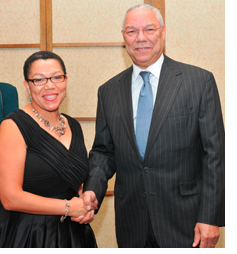 There’s a new member in the C-suite in health care, and her name is the Chief Patient Officer (CPO).
There’s a new member in the C-suite in health care, and her name is the Chief Patient Officer (CPO).
That new role in health-town is filled by Dr. Anne Beal, appointed by Sanofi, the global biopharma company, to fill this new job description. Here she is, shaking hands with Colin Powell in one of the many awards ceremonies where Dr. Beal’s work in public health has been lauded.
But what is a CPO? Because it’s a new job, Dr. Beal can create the role, at least within the environment and mission of Sanofi and the larger life sciences world. Some clues come from Sanofi’s press release welcoming Dr. Beal to the company:
The appointment of a Chief Patient Officer at Sanofi, the first for a top 10 biopharmaceutical company, shows our commitment to go further in meeting the needs of patients….Interactions with patients are a source of strength for the company and Dr. Beal’s appointment will help ensure the patient perspective advances our approach to meeting the unmet needs of patients….
Then Dr. Beal is quoted, saying,
I will use my experience as a physician, researcher, philanthropic leader, and advocate for patient access to high quality care to infuse the patient perspective into Sanofi’s work that will advance our ability to deliver health care solutions that matter most to patients and those who care for them.”
The press release was published on 31 March 2014 here in the media portal of Sanofi’s website.
You can hear directly from Dr. Beal here during a discussion on patient outcomes.
Health Populi’s Hot Points: Unpacking Sanofi’s press release, we can identify some key elements that will play into the CPO role:
Interactions with patients are a source of strength for the company. An Accenture survey of patients found that people who take medicines want more engagement with life sciences companies in the forms of information, tools for tracking and managing conditions, and financial assistance. The CPO can be a leadership point across the company’s brands to inspire and prioritize patient interactions across medical conditions. Having that high-level CPO touchpoint and beacon can help brands share best practices instead of staying siloed within the pharma company’s walls.
Unmet needs of patients. Here’s an interesting couplet for a pharma company to use: “unmet needs.” Here, Sanofi’s EVP is quoted using two words generally associated with public health, not a company listed on global stock exchanges. The CPO can start with a blank canvass to identify peoples’ needs through the lens of the company’s products, and see where services can be built around the products to enhance peoples’ lives — their ability to access the products, information and tools that can help them better self-care, source community services that can help the patient bolster their overall condition and health status (such as resources for healthy food, local face-to-face support groups, online social networks, and so one). This expands the drug company’s influence “beyond the pill.”
Patient access. In the U.S., the growth of consumer-directed health plans, health savings accounts, and greater financial responsibility on patients for paying for prescription drugs and therapies often means, because of cost, postponing the prescription fill, abandoning that Rx, or delaying seeking specialty care that’s been recommended by a personal physician. The CPO can further develop access programs that get to the patients and caregivers who most need this financial and social support. Many access programs are bureaucratic and largely in name only, for PR reasons. A meaningful access program can help expand volumes of use for company products, and gain important patient data in exchange for (via an opt-in approach) access.
Solutions that matter most to patients and those who care for them. It is instructive that Dr. Beal goes beyond the patient to “those who care for them.” We are in a caregiver-intense era in health care where adults managing aging parents and sick children often find themselves in a binding sandwich of stress, pain, financial pressure, and isolation. “Solutions for patients and caregivers” go well beyond the pill to help bolster adherence, social support, tools for managing every day life (again, beyond the medication), survivorship, and peer-to-peer support which for both patients and caregivers can make a huge difference in both clinical care and mental health.
Finally, Dr. Beal talks of the opportunity “infuse the patient perspective.” Ultimately, patient engagement and activation can be a win-win-win for patients themselves, their caregivers, their payers (including themselves sharing costs of therapies), their employers, and the company itself. Welcome the role of the CPO: she (or he) can help get the patient, person, and caregiver back into the center of the health ecosystem.





 Grateful to Gregg Malkary for inviting me to join his podcast
Grateful to Gregg Malkary for inviting me to join his podcast  This conversation with Lynn Hanessian, chief strategist at Edelman, rings truer in today's context than on the day we recorded it. We're
This conversation with Lynn Hanessian, chief strategist at Edelman, rings truer in today's context than on the day we recorded it. We're